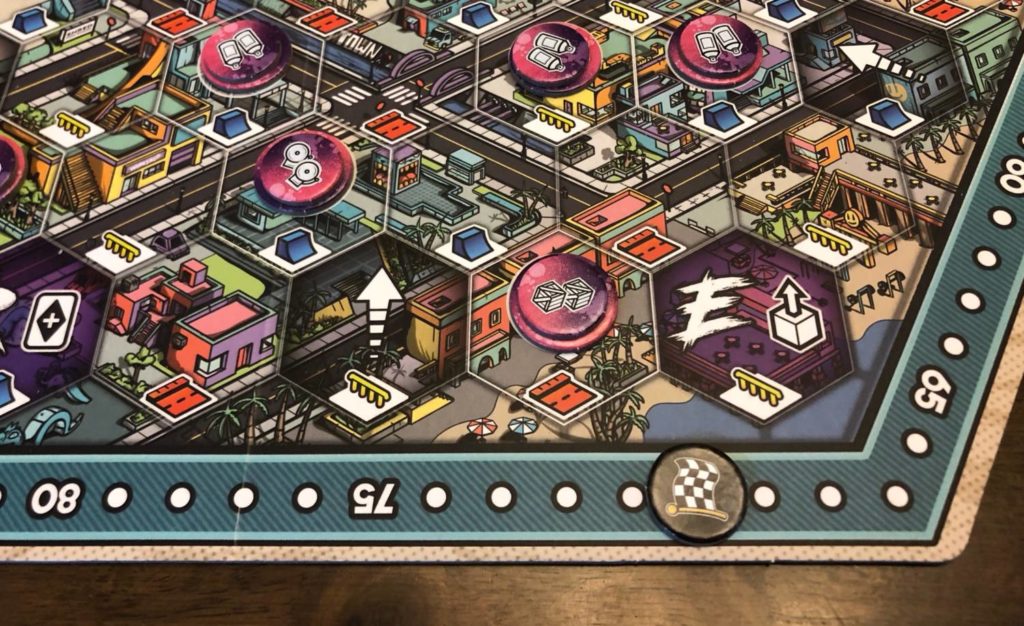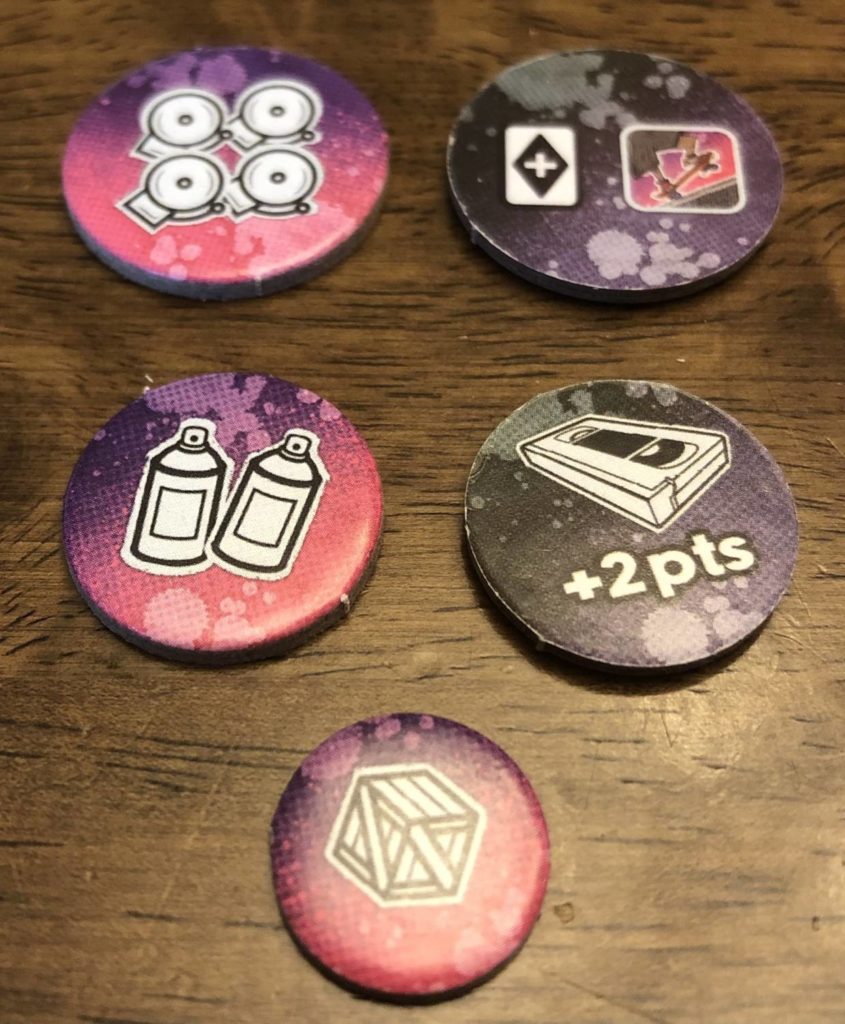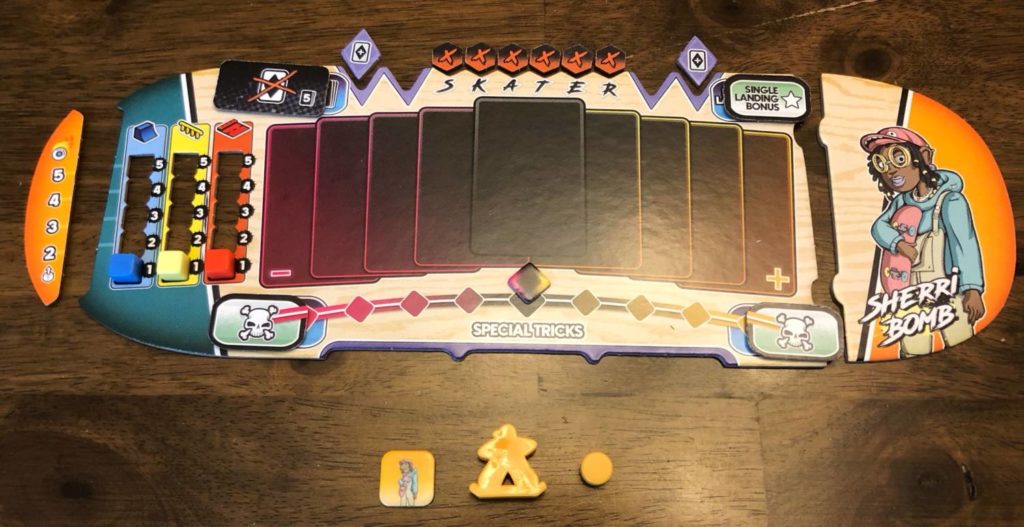Disclosure: Meeple Mountain received a free copy of this product in exchange for an honest, unbiased review. This review is not intended to be an endorsement.
For most people skateboarding may seem like a relatively recent fad that only evolved in the 1980s, but it’s actually been around for more than 75 years. The first skateboards of the 1940s and 1950s were homemade inventions, a fusion of roller skates and salvaged wood meant to emulate the feel of surfing with none of the waves. Treated as a niche curiosity for a few decades, skateboards were mostly used for simple stunts. That is, until the infamous Zephyr team and their unorthodox style revolutionized skating forever.
The Zephyr team, known colloquially as the Z-Boys (with apologies to Peggy Oki), was a group of 12 skaters from California who brought a streetwise, surfing-heavy skillset to the sport of skateboarding. They carved along banks the same way that surfers carve along waves. They practiced in empty swimming pools–usually when the unwitting pool owners weren’t home. They showed how to slide the board along railings and copings, launched themselves into the air with unusual aerial moves, and invented outlandish tricks that emphasized personal style in addition to technical ability.
In the following decades, skateboarding became increasingly mainstream while still keeping its countercultural edge. Punk and hip-hop made perfect partners for skateboarding’s energetic audience, and the low requirements for participation helped it spread across the world. Famed Z-Boy Stacy Peralta mentored the next generation of skateboarders in Tony Hawk, whose unrivaled aerial skills (and line of video games) made him a household name. Today skateboarding is even an Olympic event, showing just how far the sport has come.
Another sign of skateboarding’s enduring popularity is its transition to the tabletop with the release of Skate Summer from designer Randy Reiman and Pandasaurus Games. Can they capture the allure of skateboards…in cardboard?

Getting Technical
In Skate Summer, the goal is to have the most points at the end of the game. Points come from landing various skating Tricks, collecting Goal icons, and maximizing your skater’s personal abilities. Once a player reaches the end-of-game scoring threshold, the current round wraps up and a winner is crowned.
Naturally, each round begins with players doing what you’d expect skateboarders to do: throw down some sick tricks! All players will simultaneously pick one Trick card from their hand and play it to the center spot of their personal player board.

Tricks come in three types (red is for fliptricks, yellow is for grinds, and blue is for grabs–though in practice you don’t need to know the difference) and each trick card features two sets of arrows: one set in the bottom left of the card and the other in the bottom right. These arrows tell you what rewards you’ll get immediately for playing the trick, as well as how to adjust your balance track.
As in real skateboarding, balance is everything: you can only go so far in either direction before you bail out and embarrass yourself in front of all your friends. Each trick moves your balance token 1-3 spots on the track in a single direction. After all players have laid down their trick, the active player will roll the dice to see who takes a spill and who’s still riding high. One of these dice is always the Direction die, which shows + and – signs (right and left, respectively, on the tracker). The remaining dice are Balance dice, which have two empty sides and four sides containing a single lightning bolt. For each lightning bolt that comes up, all players will adjust their balance 1 space in the indicated direction. If a player goes off the edge of their track, they’ll bail and lose some of their rewards from the round.

Anyone who hasn’t hit the edge of their track has to make the choice to either land their line of tricks cleanly, meaning they won’t play any more tricks this round, or keep going. When a player lands (or bails) they immediately place their marker on the Landing Spot track, setting their turn order for the movement phase of the round and getting a few rewards as compensation for not being able to continue.
Players that choose to keep their line alive can play their next card either to the left or right of their center card, using the set of arrows (and rewards) on that side of the card. After this, there’s another roll of the dice, but with an extra Balance die since there are now two tricks in the sequence. This process keeps going: play a third trick and you’ll be rolling with three Balance dice, etc. The round only ends when all players either land their combo, bail out, or can’t play any further cards.

Of course, the longer you can stay in, the more rewards you’ll get. Each Trick immediately earns the player either Flames (the game’s main currency) or one of the three Goal icons (crate, bell, and spray can) which are scored at the end of the game. If a player bails out, they’ll have to discard their most-recent trick card AND lose half of their current Flames. Ouch! If a player lands cleanly, they also get a bonus: they get to increase one of their Skills for free.
Skills represent, well, your skater’s skill (rated 1-5) at each of the three Trick types. The higher the Skill, the more points that type is worth. After the Trick phase, each player can spend Flames to increase their Skills, then all players score each successful Trick in their line based on type and current value. This is the main source of points in the game, so don’t neglect your Skills!
Four Wheels Down
Once all players have completed and scored their Trick line, it’s on to the next phase of the round: skating the park. In Landing Spot order, players will “spend” the cards from their trick line to move around the park’s map. Each hex space has one of the three trick icons; discard a played card of that type to move into that hex. Players can spend Manual tokens they’ve earned to move into a hex even if they don’t have the right type, allowing for major mobility despite an anemic trick line.

The map also holds a few other opportunities. Most notable of these are the player board improvements. These 6 spaces–each affiliated with a letter from the word SKATER–immediately boost your skater at no additional cost when the skater enters the space. Some spaces expand your balance track, giving you a little more wiggle room when playing Tricks, while others increase your hand size or make it easier to access Special Tricks, a unique type which provide powerful abilities. If you can gather all 6 spaces, you’ll get a bonus 10 points at the end of the game.
Some spaces feature Goal icon tokens in two sizes (2 and 4). As players move into these spaces, they can pay that many Flames to claim the topmost token. These tokens not only aid in getting sets of icons, but also offer free rewards on the backside when claimed. This can be as simple as an extra 2 points or as exciting as a free Special Trick card.

And what would a skate spot be without vert ramps and a massive halfpipe? The center of the board holds the Big Air space. If a player moves here, they can immediately roll the Big Air die and move that many spaces in a single direction. It’s unpredictable, but that’s what makes it exciting. Players can also use Revert Ramps at the edges of the map to launch themselves from the Big Air space, crossing the map at high speed. While the movement aspect of the game feels perfunctory at times, making the most of your line to set up your trip across the park is what separates the high-fliers from the groundbound.
Once all players have moved, the game ends if any player has crossed the scoring threshold (70 points by default). If anyone has, all players check how many of each Goal icon they have, scoring 8 points for most and 4 points for second-most, plus an additional 10 points for maxing out your skater’s ability. Add those points to the existing total to find the winner!
Speed Wobbles
Skate Summer is an eye-catching production, with its individual player boards, mini-decks of cards, custom dice, and stylish graphics. For the most part, that’s a positive. Even players who’ve never seen a skateboard can still get into the game’s theme, though skateboarding aficionados will likely enjoy it significantly more. Fun nods to skateboarding tricks and techniques, like the character name Noah Comply and the manual tokens that allow you to move further on the map, are sprinkled throughout the game. (The Skaters were all named through a contest on Twitter, with the winners credited in the rulebook as well as receiving a Special Edition of the game.) While the map is slightly harder to read at first blush than I would like, the graphics draw on the over-the-top art traditionally associated with skateboarding in a way that ultimately complements the experience.
The downside of the production is that this is, perhaps, the most fiddly game I have ever played. There are quite a few tokens to shuffle and place on the board, three different ways to represent your character, multiple piles of rewards to sort out, and so forth. None of these are quite as egregious as the player boards, though: the rulebook features a whopping SIXTEEN STEPS to set up EACH player’s starting board. That’s more setup for just one person than many games have in total. If you’re planning to teach this to new players, take my advice and set everything up beforehand so that they don’t have to watch you slowly count out each player’s allotment of fingernail-sized tokens and tiny cubes. This also helps you get right to the teach, which itself is made more complex by the sheer number of pieces to consider.

An experience like that is worthwhile only if the game delivers the goods, and for the most part Skate Summer does. The game isn’t exactly dense, but it’s got enough to grip you for its 60-minute runtime. The highlight is the Trick phase, where all the game’s systems collide. Every Trick matters for so many different reasons: balance, short-term rewards, long-term rewards, and movement. Skate Summer is at its best when you’re debating whether to play that one last Trick, the one you know in your heart is too risky, because skating away with a handful of good rewards isn’t nearly as satisfying as landing the perfect line.
That does, however, require a certain amount of buy-in from the group. The theme and table presence are polarizing. Some players are going to be stoked to drop an Airwalk and grab a bunch of Flames while throwing everyone the metal horns, and for those players, Skate Summer is undeniably fun. (It’s me, I’m one of those players.) For everyone else, it’s admittedly a harder sell. The game’s teach time, fiddliness, and pace all feel just slightly off compared to what one might expect from the game’s presentation. Players who are particularly sensitive to any one of those elements–whether they’re easily bored or just hate when their pieces don’t line up right–are probably going to be a little disappointed.
Personally, I think it’s worth persevering despite those rough edges. Skate Summer might not be everyone’s jam, but there’s a good game here if you’re willing to ride it out.












Add Comment